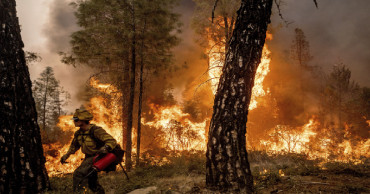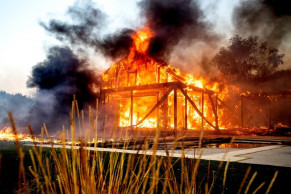Northern California
Threat from Western fires persists despite favorable weather
Firefighters made progress against a huge Northern California wildfire that was still growing and threatening thousands of mountain homes on Sunday, while crews also battled major blazes that blanketed large swaths of Oregon and Washington in smoke.
The Mosquito Fire in foothills east of Sacramento spread to nearly 65 square miles (168 square kilometers), with 10% containment, according to the California Department of Forestry and Fire Protection, or Cal Fire.
“Cooler temperatures and higher humidity assisted with moderating some fire activity,” but higher winds allowed the flames to push to the north and northeast, according to a Cal Fire incident report Sunday.
More than 5,800 structures in Placer and El Dorado counties were under threat and some 11,000 residents of communities including Foresthill and Georgetown were under evacuation orders.
In Southern California, cooler temperatures and rain brought respite to firefighters battling the massive Fairview Fire about 75 miles (121 kilometers) southeast of Los Angeles after sweltering heat last week.
Read: Storm’s fierce winds complicate California wildfire fight
The 44-square-mile (114-square-kilometer) blaze was 45% contained Sunday. The fire has destroyed at least 30 homes and other structures in Riverside County. Two people died while fleeing flames last Monday.
A helicopter assisting with operations in the Fairview Fire crashed in a residential backyard while attempting to land at a local airport Saturday afternoon, fire officials said. Injuries to the pilot and two others were not critical.
The southern part of the state welcomed the cooler weekend weather as a tropical storm veered off the Pacific Coast and faded, helping put an end to blistering temperatures that nearly overwhelmed the state’s electrical grid.
Thunderstorms and the risk of flooding persisted in mountainous areas of greater Los Angeles on Sunday. But after Hurricane Kay made landfall in Mexico last week it quickly was downgraded and weakened further until it largely disappeared, forecasters said.
To the north, remnants of Kay caused flooding Saturday that stranded about 40 vehicles and closed a stretch of State Route 190 in Death Valley National Park. The park was still cleaning up from floods five weeks ago that closed many key roads.
In Washington state, fire officials were scrambling to secure resources in the battle against a blaze sparked Saturday in the remote Stevens Pass area that sent hikers fleeing and forced evacuations of mountain communities. There was no containment Sunday of the Bolt Creek Fire, which had scorched nearly 12 square miles (31 square kilometers) of forestland about an hour and a half east of Seattle.
“The fire will continue to advance in areas that will be unstaffed. With limited resources, only point protection will be in place while resources continue to mobilize to the fire,” said a Sunday morning incident report.
California's Mosquito Fire has covered a large portion of the Northern Sierra region with smoke. California health officials urged people in affected areas to stay indoors where possible. Organizers of the Tour de Tahoe canceled the annual 72-mile (115-km) bicycle ride scheduled Sunday around Lake Tahoe because of the heavy smoke from the blaze — more than 50 miles (80 km) away. Last year’s ride was canceled because of smoke from another big fire south of Tahoe.
Read: 2 killed in Northern California wildfire: Sheriff
The Mosquito Fire’s cause remained under investigation. Pacific Gas & Electric said unspecified “electrical activity” occurred close in time to the report of the fire on Tuesday.
Scientists say climate change has made the West warmer and drier over the last three decades and will continue to make weather more extreme and wildfires more frequent and destructive. In the last five years, California has experienced the largest and most destructive fires in state history.
And the rest of the West hasn’t been immune. There were at least 18 large fires burning in Oregon and Washington, leading to evacuations and targeted power outages near Portland as the challenge of dry and windy conditions continued in the region.
Sprawling areas of western Oregon choked by thick smoke from the fires in recent days were expected to see improved air quality on Sunday thanks to a returning onshore flow, Oregon Public Broadcasting reported.
South of Portland, more than 3,000 residents were under new evacuation orders because of the 134-square-mile (347-square-kilometer) Cedar Creek Fire, which has burned for over a month across Lane and Deschutes counties. Firefighters were protecting remote homes in Oakridge, Westfir and surrounding mountain communities.
According to the Northwest Interagency Coordination Center, this weekend there were more than 400 square miles (1,035 square kilometers) of active, uncontained fires and nearly 5,000 people on the ground fighting them in the two northwestern states.
3 years ago
Climate change makes drought recovery tougher in U.S. West
Californians rejoiced this week when big drops of water started falling from the sky for the first time in any measurable way since the spring, an annual soaking that heralds the start of the rainy season following some of the hottest and driest months on record.
But as the rain was beginning to fall on Tuesday night, Gov. Gavin Newsom did a curious thing: He issued a statewide drought emergency and gave regulators permission to enact mandatory statewide water restrictions if they choose.
Newsom's order might seem jarring, especially as forecasters predict up to 7 inches (18 centimeters) of rain could fall on parts of the Northern California mountains and Central Valley this week. But experts say it makes sense if you think of drought as something caused not by the weather, but by climate change.
Read: Wildfires rage as US West grapples with heat wave, drought
For decades, California has relied on rain and snow in the winter to fill the state's major rivers and streams in the spring, which then feed a massive system of lakes that store water for drinking, farming and energy production. But that annual runoff from the mountains is getting smaller, mostly because it's getting hotter and drier, not just because it's raining less.
In the spring, California's snowpack in the Sierra Nevada mountains was 60% of its historical average. But the amount of water that made it to the reservoirs was similar to 2015, when the snowpack was just 5% of its historical average. Nearly all of the water state officials had expected to get this year either evaporated into the hotter air or was absorbed into the drier soil.
“You don’t get into the type of drought that we're seeing in the American West right now just from ... missing a few storms,” said Justin Mankin, a geography professor at Dartmouth College and co-lead of the Drought Task Force at the National Oceanic and Atmospheric Administration. “A warm atmosphere evaporates more water from the land surface (and) reduces (the) amount of water available for other uses, like people and hydropower and growing crops.”
California's “water year” runs from Oct. 1 to Sept. 30. The 2021 water year, which just ended, was the second driest on record. The one before that was the fifth driest on record. Some of the state's most important reservoirs are at record low levels. Things are so bad in Lake Mendocino that state officials say it could be dry by next summer.
Even if California were to have above-average rain and snow this winter, warming temperatures mean it still likely won't be enough to make up for all the water California lost. This past year, California had its warmest ever statewide monthly average temperatures in June, July and October 2020.
Jeanine Jones, interstate resources manager for the California Department of Water Resources, said people should not think about drought “as being just this occasional thing that happens sometimes, and then we go back to a wetter system.”
“We are really transitioning to a drier system so, you know, dry becomes the new normal," she said. “Drought is not a short-term feature. Droughts take time to develop, and they usually linger for quite some time."
Water regulators have already ordered some farmers and other big users to stop taking water out of the state's major rivers and streams. Mandatory water restrictions for regular people could be next.
Read: Why the world should pay attention to Taiwan's drought
In July, Newsom asked people to voluntarily reduce their water use by 15%. In July and August, people cut back 3.5%. On Tuesday, Newsom issued an executive order giving state regulators permission to impose mandatory restrictions, including banning people from washing their cars, using water to clean sidewalks and driveways and filling decorative fountains.
State officials have warned water agencies that they might not get any water from the state's reservoirs this year, at least initially. That will be very challenging, said Dave Eggerton, executive director of the Association of California Water Agencies.
But he said he believes Californians will start to conserve more water soon with the help of a statewide conservation campaign, which will include messages on electronic signboards along busy highways.
“It's going to happen,” he said. “People are starting to get the message, and they want to do their part.”
4 years ago
Northern California wildfire leaves 3 dead
Three people died in a wind-whipped Northern California wildfire that has forced thousands of people from their homes while carving a 25-mile path of destruction through mountainous terrain and parched foothills, authorities said Wednesday.
5 years ago
Northern California city struggles with coronavirus mystery
Residents of a Northern California community are at the epicenter of what officials are calling a turning point in the spread of the highly contagious coronavirus, as investigators try to retrace the steps of a hospitalized patient they believe to be the first in the U.S. to be infected without traveling internationally or being in close contact with anyone who had it.
5 years ago
Northern California city struggles with coronavirus mystery
Residents of a Northern California community are at the epicenter of what officials are calling a turning point in the spread of the highly contagious coronavirus, as investigators try to retrace the steps of a hospitalized patient they believe to be the first in the U.S. to be infected without traveling internationally or being in close contact with anyone who had it.
5 years ago
Two people die of alleged use of illegal drugs in Northern California
A male and a female have been killed for allegedly using illegal drugs in Marin County, Northern California, a Bay Area TV station reported Saturday.
5 years ago
Fires spread amid power outages in Northern California
Santa Rosa, California, Oct 28(AP/UNB) — As nearly 200,000 people remain under evacuation order from threat of wildfire, some of the millions of people in Northern California on track to get their electricity back may not have power restored before another possible round of shut-offs and debilitating winds.
6 years ago


.jpg)
.jpg)


